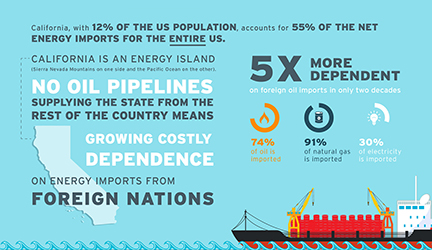The History of Oil and Natural Gas in California
You may think that California was built by the movie business, or by Silicon Valley tech companies. But, before either of those, there was oil. In many ways, the history of California in the past 150 years has been the history of oil. For a century and a half, the state’s ample petroleum resources have spurred growth and prosperity throughout all sectors of our economy and, with investments from the California energy industry, even helped to establish moviemaking in Hollywood. Fast forward to today, with the oil and natural gas industry employing 142,780 Californians with an average annual salary of more than $84,000 and contributing $26 billion in tax revenues to state and local governments in 2015.
California is blessed with accessible oil and natural gas resources that range from surface deposits of crude oil in places like the La Brea Tar Pits and along the Ventura and Santa Barbara coastline to oil and gas formations over 14,000 feet deep. Native Americans used the tarry material, which collected in open “seeps,” such as those visible today on rocks along the highway near Ojai, to caulk boats and strengthen tools. Early settlers discovered ways to distill the substance to create lamp oil, replacing oil from whales and seals.
As our state continues to diversify with growing technology and services sectors, California oil and natural gas production remains an economic powerhouse essential to meeting the state’s rising energy demand.
By the 1860s, entrepreneurs were turning oil into mass-produced kerosene for home lighting, and in 1870, California’s first oil well was drilled. Soon, oil drillers were developing new extraction techniques, which made oil — and eventually natural gas — the focus of a flourishing new industry in California from Orange County to Sacramento. The new fuels improved Californians’ quality of life, replacing whale oil and wood burning appliances and keeping homes, schools, businesses and hospitals safely and reliably lit. The galvanizing influence of these fuels on the state economy was inevitable. Produced from the ground, they quickly became natural drivers of prosperity, fueling industry, agriculture and transportation.
Around the turn of the 20th century, drillers discovered massive reserves in places like Kern County, and, by the 1920s, California was the world’s leading oil producer, with 57 refineries processing 186 million barrels of oil a year.
Oil production, as California’s leading sector, fed the economy of the fast-growing state. “Oil money funded huge real estate developments and encourage construction of roads and highways,” historian Eric Schlosser told the New York Times in a 2008 interview. “Hollywood was born in the decade from around 1911 to 1921, and oil money financed some of the new films.” Thanks to the oil industry, Los Angeles, Orange and Kern counties began to thrive and diversify their economies. California’s oil and natural gas production was also instrumental in powering the industries that helped the United States and our allies prevail in World Wars I and II.
As our state continues to diversify with growing technology and services sectors, California oil and natural gas production remains an economic powerhouse essential to meeting the state’s rising energy demand. These days, the state produces about 14 million barrels of oil a month. It is also part of the natural-gas revolution: California produced more than 200 million cubic feet of natural gas in 2017 used for heating and cooking in homes and businesses and to generate electricity. The good news is that California has plentiful oil and natural gas resources beneath its surface to provide ample, affordable and reliable energy to California homes, farms, businesses and communities well into the future.

